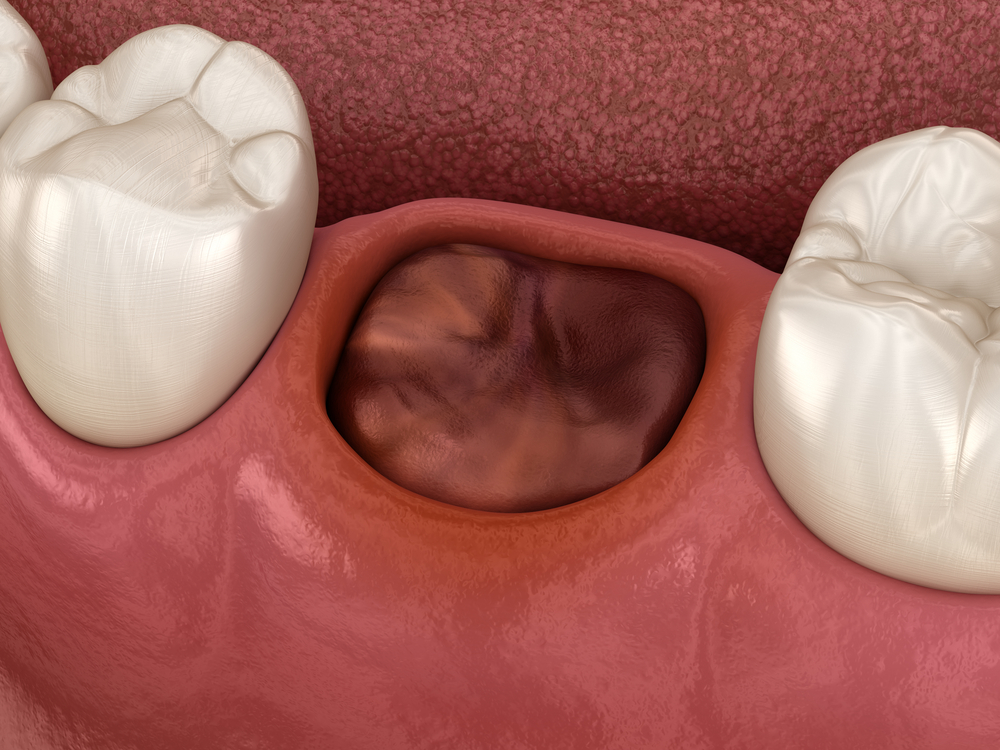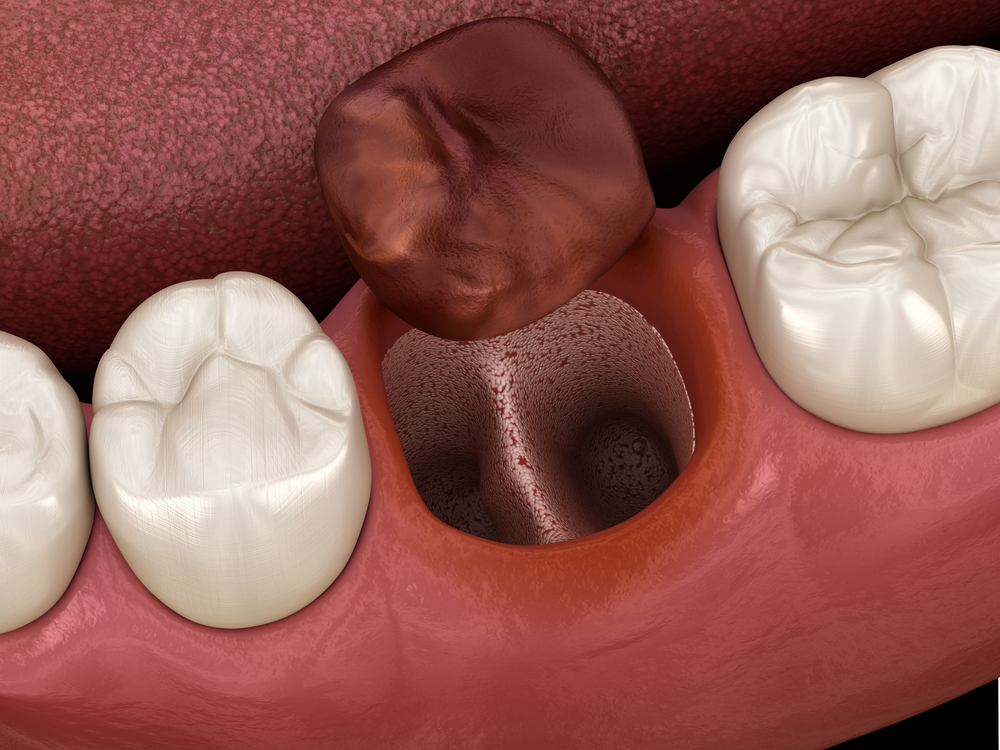
Dry socket, also known as alveolar osteitis, is a condition that can occur after a tooth extraction. It happens when the blood clot at the site of the tooth extraction fails to develop, or it dislodges or dissolves before the wound has healed. Understanding how long dry socket lasts is important for managing expectations and ensuring a smooth recovery process. In this guide, we’ll explore the duration of dry socket, its symptoms, treatment options, and ways to prevent it, providing you with the essential knowledge to navigate this uncomfortable condition.
What is a “Dry Socket”?

Dry socket is a painful dental condition that may occur after you have a tooth extracted. It occurs when the blood clot that should form in the socket to protect the underlying bone, and serve as the basis for healing, either doesn’t form properly or is dislodged. Without this clot, the area is exposed to air, food, and bacteria, leading to pain and a slower healing process.
Causes of Dry Socket:
- Improper Blood Clot Formation: The clot fails to develop in the socket after tooth extraction.
- Dislodgement: Physical activities, vigorous rinsing, or sucking motions (like smoking or using straws) can dislodge the protective clot.
- Infection: Pre-existing infection in the mouth can prevent clot formation.
Difference from Normal Healing:
- Normal Healing: Typically involves a blood clot forming to protect the socket, followed by gradual tissue regeneration.
- Dry Socket: The absence of a blood clot leads to exposed bone, resulting in increased pain and risk of infection.
Understanding dry socket is the first step in preventing and managing this condition effectively, ensuring a smoother recovery after tooth extraction.
Symptoms of Dry Socket
Dry socket can significantly disrupt the healing process after a tooth extraction, leading to distinct symptoms that differentiate it from normal post-operative discomfort. Recognizing these symptoms early is key to seeking timely treatment and relief.
Key Symptoms Include:
Severe Pain: Unlike the typical discomfort following a tooth extraction, dry socket pain is intense and can radiate to the ear, eye, temple, or neck on the same side of the face as the extraction.
Visible Bone: In cases of dry socket, the protective blood clot is missing, and you may be able to see the bone within the socket.
Unpleasant Taste and Odor: A bad taste in the mouth and foul breath are common due to the exposed socket and potential infection.
Lack of Healing: The extraction site appears to not be healing as expected, with increased pain instead of gradual improvement over time.
Differentiation from Normal Symptoms:
While some pain and discomfort are normal after a tooth extraction, the symptoms of dry socket are more severe and persist beyond the usual healing period. Normal healing involves minor pain that improves with time, slight swelling, and the presence of a blood clot in the socket, none of which are present with dry socket.
Early recognition and treatment of dry socket can significantly reduce discomfort and speed up the healing process. If you experience any of these symptoms after a tooth extraction, contact your dentist as soon as possible.
Factors Influencing Dry Socket Duration
The healing time for dry socket can vary significantly from one individual to another, influenced by several key factors. Understanding these can help manage expectations and potentially reduce recovery time.
Key Factors Include:
Smoking and Tobacco Use: Smoking not only increases the risk of developing dry socket but can also prolong the healing process due to its impact on blood flow and wound healing.
Oral Hygiene Practices: Poor oral hygiene can lead to an increased risk of infection in the extraction site, delaying the healing process. Conversely, proper care can promote proper healing.
Nature of the Dental Extraction: The complexity of the extraction, especially wisdom teeth removal, can influence the risk and duration of dry socket. More invasive or difficult extractions may lead to longer healing and recovery times.
Managing Recovery Time:
Follow Post-Extraction Care Instructions: Adhering to your dentist’s advice on oral care after extraction is crucial for minimizing the duration of dry socket.
Avoid Risky Behaviors: Refraining from smoking, using straws, and engaging in vigorous rinsing or spitting can help protect the clot and promote healing.
Seek Prompt Treatment: If symptoms of dry socket appear, immediate treatment by a dental professional can alleviate pain and speed up the healing process.
Understanding these factors and how they impact the healing timeline allows for better preparation and management of dry socket, leading to a smoother and potentially quicker recovery.
Average Duration of Dry Socket
The experience of dry socket varies among patients, but understanding its typical duration can provide a timeline for recovery and when to expect relief from symptoms.
General Timeframe:
Onset: Dry socket often manifests 2 to 3 days after a tooth extraction, once the initial pain of the extraction begins to subside.
Peak Symptoms: The intensity of dry socket pain often peaks within the first few days of its onset and can be quite severe.
Healing Period: With proper treatment, symptoms of dry socket typically improve within 7 to 10 days. Complete healing of the socket might take a few weeks, depending on individual health factors and adherence to care instructions.
What to Expect During the Healing Process
Navigating the healing journey from dry socket requires an understanding of what to expect during recovery, ensuring you’re prepared for the process and can contribute actively to your healing.
Initial Treatment: Treatment by a dental professional can significantly alleviate pain and promote healing. This may include cleaning the socket, applying medicated dressings, and prescribing pain management solutions.
Follow-Up Care: Regular follow-up visits may be necessary to change dressings and ensure the socket is healing properly.
Gradual Improvement: Pain and discomfort should gradually decrease over time as the socket begins to heal. It’s important to continue following oral hygiene instructions and any specific care guidelines recommended by your dentist.
Role of Home-Care
Home care is an important step in the recovery from dry socket, as it significantly influences the healing timeline and overall comfort during the process.
Oral Hygiene: Maintaining gentle yet effective oral hygiene around the extraction site is crucial to prevent further complications.
- Diet: Consuming soft, nutritious foods and avoiding anything that might disturb the extraction site can aid in the healing process.
- Rest: Giving your body ample rest and avoiding strenuous activities can speed up recovery.
Understanding the expected duration of dry socket and the healing process helps manage patient expectations and underscores the importance of following professional dental advice for a quicker recovery.
Treatment Options for Dry Socket
Effective management of dry socket involves a combination of professional dental treatments and supportive home care to alleviate pain and facilitate healing.
Professional Treatments

Addressing dry socket effectively often requires professional intervention, where a range of treatments are deployed to mitigate pain and facilitate healing.
Socket Cleaning: Your dentist will gently clean the socket to remove any debris or food particles, reducing the risk of infection and promoting healing.
Medicated Dressings: A medicated dressing or packing may be placed in the socket to protect it and reduce pain. These dressings are usually replaced every few days.
Pain Management: Over-the-counter pain relievers or prescription medications can be recommended to manage pain. Nonsteroidal anti-inflammatory drugs (NSAIDs) are commonly used.
Antibiotics: If there is evidence of infection, your dentist may prescribe antibiotics to prevent further complications.
Immediate Care Steps at Home
While awaiting or complementing professional treatment, there are several steps you can take at home to ease discomfort and encourage recovery.
Saltwater Rinses: Gently rinsing your mouth with warm salt water can help soothe the area and keep it clean, but avoid vigorous rinsing to prevent dislodging any new clot forming.
Cold Compresses: Applying a cold compress to the outside of your cheek can reduce swelling and provide pain relief.
Soft Foods: Eating soft foods that require minimal chewing can help prevent irritation to the extraction site.
Importance of Follow-Up Visits
Regular follow-up visits to the dentist are crucial for ensuring the socket is healing properly and to adjust treatment as needed. These visits also provide an opportunity to address any concerns or complications that may arise during the healing process.
Effective treatment of dry socket not only alleviates pain but also accelerates the healing process, reducing the overall duration of the condition and preventing further oral health issues.
Home Remedies and Pain Management
Managing the symptoms of dry socket at home is crucial for comfort and can assist in the healing process. Here are some effective strategies:
Safe Home Remedies to Alleviate Symptoms:

Several home remedies can provide relief and support healing in the case of dry socket, complementing professional treatments without interfering with the healing process.
Clove Oil: Known for its pain-relieving properties, a small amount of clove oil applied to the socket can help reduce discomfort.
Tea Bags: A moistened tea bag, especially black tea, can be placed over the socket. Tannic acid in the tea helps reduce pain and swelling.
Effective Pain Management Strategies:
Pain management is a cornerstone of dry socket treatment, utilizing over-the-counter medications to ease discomfort.
Over-the-Counter Pain Relievers: Medications such as ibuprofen or acetaminophen can be effective in managing pain. Always follow the dosage instructions or your dentist’s recommendation.
Cold Compresses: For swelling and pain, applying a cold compress to the cheek near the extraction site can offer temporary relief.
Avoidance of Aggravating Activities: Reducing activities that increase pain, such as chewing on the affected side, smoking, or drinking through a straw, is crucial for pain management.
Incorporating these home remedies and pain management strategies into your care routine can significantly improve your comfort levels and aid in the healing process of dry socket.
Preventing Dry Socket
Preventing dry socket is key to a smooth recovery following a tooth extraction. By understanding and applying preventive measures, the risk of this painful condition can be significantly reduced.
Tips on Preventing Dry Socket After Tooth Extraction:
Adopting certain practices before and after tooth extraction can greatly diminish the likelihood of developing dry socket, ensuring a more comfortable healing process.
Follow Pre-Extraction Instructions: Adhering to your dentist’s advice before the procedure can prepare your mouth for optimal healing.
Avoid Smoking and Tobacco Use: Smoking is one of the leading causes of dry socket. Abstaining from tobacco products before and after extraction promotes clot formation and healing.
Careful Eating Habits: Stick to soft foods and avoid using the extraction site for chewing. This helps protect the blood clot.
Oral Hygiene: Maintain gentle oral hygiene practices without disturbing the extraction site. Rinsing with salt water after the first 24 hours, as recommended by your dentist, can help keep the area clean.
How Pre-Extraction Consultation Can Help Minimize Risks:
Engaging in a thorough consultation with your dentist prior to extraction can identify potential risk factors for dry socket, allowing for preventive strategies to be put in place.
Medical History Review: Discussing your medical and dental history can help your dentist anticipate potential complications and advise accordingly.
Personalized Advice: Your dentist can provide personalized recommendations based on your specific health profile and the nature of your extraction.
Taking proactive steps to prevent dry socket not only reduces post-operative pain but also accelerates the healing process, leading to a better overall recovery experience.
When to See a Dentist
Recognizing when to seek professional dental care is crucial for effectively managing dry socket and preventing further complications. Here are guidelines on when to consult your dentist:
Signs That It’s Time to Consult Your Dentist:
If you’re experiencing symptoms that deviate from the normal healing process, it may be time to reach out to your dentist for advice and possible intervention.
Persistent, Severe Pain: If pain does not subside with over-the-counter medications or worsens over time, it’s a clear signal to seek professional help.
Visible Bone in the Socket: The absence of a blood clot and visible bone within the extraction site are indicative of dry socket.
Unpleasant Taste or Odor: A bad taste in the mouth or foul breath despite good oral hygiene practices can suggest an infection requiring dental attention.
Fever and General Malaise: These symptoms could indicate an infection that extends beyond the extraction site.
Expected Outcomes After Professional Treatment:
Professional treatment for dry socket aims to alleviate pain, encourage healing, and prevent further oral health issues.
Pain Relief: One of the immediate benefits of seeking dental care is the significant reduction in pain.
Accelerated Healing: With appropriate intervention, the healing process can be expedited, leading to quicker recovery.
Prevention of Complications: Timely dental care helps prevent potential complications, such as infection or delayed healing.
Consulting a dentist at the right time is vital for managing dry socket effectively. If you’re unsure about your symptoms or how to care for your extraction site, it’s always better to err on the side of caution and make an appointment with your dental professional.
FAQs
Addressing frequently asked questions about dry socket can provide readers with quick, accessible information and further clarify common concerns. Here are some typical
FAQs:
How can I tell if I have dry socket?
If you experience intense pain a few days after a tooth extraction, visible bone in the socket, a bad taste, or odor coming from the extraction site, you may have dry socket. These symptoms are significantly different from normal post-extraction healing.
What is the fastest way to cure dry socket?
The fastest way to alleviate dry socket symptoms is to seek professional dental treatment. Your dentist can clean the socket, apply medicated dressings, and prescribe pain relief methods to manage the condition effectively.
Can I eat normally with dry socket?
It’s best to avoid eating hard, crunchy, or spicy foods that can irritate the socket. Stick to soft, nutritious foods and chew on the opposite side of your mouth to prevent further complications.
How often should I change the dressing for dry socket?
Dressing changes for dry socket are typically managed by your dentist, who will advise on the frequency based on the severity of your condition. Generally, dressings may need to be changed every few days until symptoms improve.
Can dry socket heal on its own without treatment?
While minor cases of dry socket may eventually heal on their own, seeking professional treatment can significantly reduce pain and accelerate the healing process. Untreated dry socket can lead to increased discomfort and potential complications.
These FAQs aim to address the most common queries related to dry socket, providing readers with concise, straightforward answers that complement the detailed information provided in the earlier sections of the blog.
Conclusion
Navigating the journey of recovery from dry socket requires understanding its symptoms, treatment options, and preventive measures. While the condition can be painful and unsettling, effective management strategies can significantly alleviate discomfort and promote healing.
Recap of Key Points:
- Understanding Dry Socket: Recognizing the signs and symptoms of dry socket is crucial for timely treatment.
- Effective Management: Both professional treatments, and at-home care, play pivotal roles in managing dry socket, reducing pain, and promoting the healing process.
- Prevention is Key: Adopting preventive measures before and after tooth extraction can greatly reduce the risk of developing dry socket.
Following your dentist’s advice for pre- and post-extraction care is paramount. Their guidance, tailored to your specific health needs, can not only prevent dry socket but also ensure a smoother recovery from any dental procedure.

